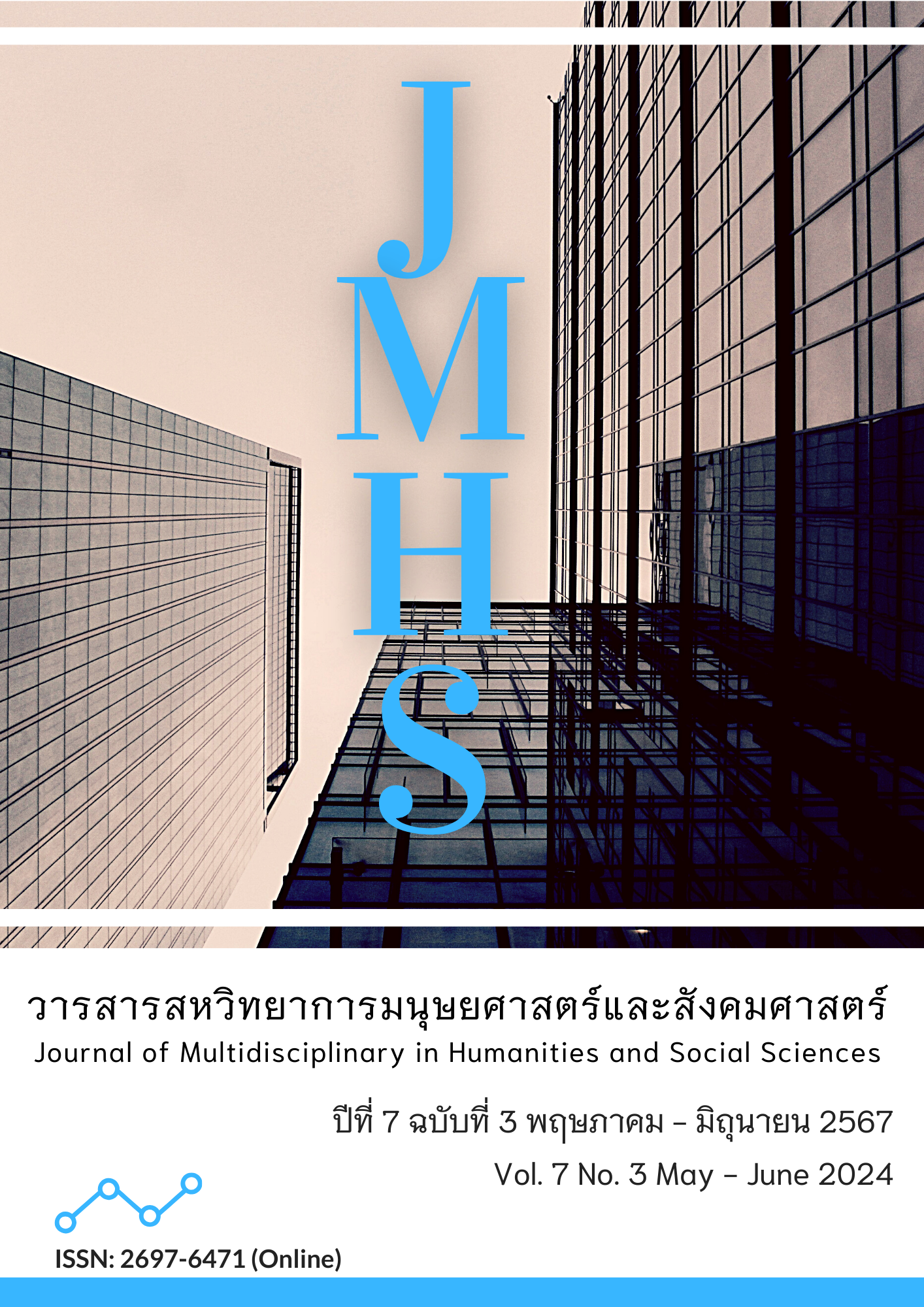The Effect of Instructional Model using Project-Based Learning with Graphic Organizers to Enhance for Secondary Students’ Computational Thinking
Main Article Content
Abstract
The objectives of this research were to: 1) compare the computational thinking skills of the sample groups between pre-learning and post-learning through the instructional model using project-based learning with graphic organizers to enhance computational thinking skills for secondary school students; 2) observe students' participation behavior; 3) evaluate students' project performance; 4) evaluate the quality of students' projects; 5) evaluate self-assessment of their computational thinking skills; and 6) study students’ satisfaction and teachers' opinions regarding the developed instructional model. The study employed a research-and-development model. The research employs a simple random sampling method. The tools used in the research include: 1) the instructional package according to the developed instructional model; 2) a computational thinking skills assessment form; 3) a participation behavior observation form; 4) a project performance evaluation form; 5) a project quality assessment form; 6) a self-assessment form for computational thinking skills; 7) a student satisfaction questionnaire; and 8) a relevant instructor interview form. Statistics used in data analysis were mean, standard deviation (SD), mean percentage (%), and t-test.
It was found that 1) the computational thinking skills of students learning with the instructional model after learning were higher than before learning; it was statistically significant at the.05 level; and 2) participation behavior in student project development, it was at a very good level; 3) students' project performance was at a good level very good; 4) the assessment of the quality of students' projects were at a very good level; 5) students self-assessed their computational thinking skills at a good and excellent level in all four components, more than 80 percent; 6) the results from a questionnaire revealed that the students were satisfied at the highest level with instructional model; and 7) opinions of related teachers, it can be concluded that the instructional model using project-based learning with graphic organizer to enhance computational thinking skills for secondary school students.
Article Details

This work is licensed under a Creative Commons Attribution-NonCommercial-NoDerivatives 4.0 International License.
Views and opinions appearing in the Journal it is the responsibility of the author of the article, and does not constitute the view and responsibility of the editorial team.
References
ชัยวัฒน์ สุทธิรัตน์. (2561). นวัตกรรมการจัดการเรียนรู้ที่เน้นผู้เรียนเป็นสำคัญ. นนทบุรี: พีบาลานซ์ ดีไซด์แอนปริ๊นติ้ง.
ปราโมทย์ พรหมขันธ์, กนิษฐ์กานต์ ปันแก้ว, ฟิสิกส์ ฌอณ บัวกนก, พงศพัทธ์ โพธิ, ตุลา คุ้มครอง, และ ปวีณา เครือจันต๊ะ. (2565). การพัฒนาทักษะการคิดเชิงคำนวณของนักศึกษาครูสาขาวิชาคอมพิวเตอร์โดยใช้ผังกราฟิก. วารสารมหาวิทยาลัยราชภัฏลำปาง, 11(1), 55-65.
พรรณิสรา จั่นแย้ม และ ปราวีณยา สุวรรณณัฐโชติ.(2563). การใช้ผังความคิดกราฟิกแบบร่วมมือออนไลน์ในการเรียนโดยใช้โครงงานเป็นฐานเพื่อเสริมสร้างการแก้ปัญหาอย่างสร้างสรรค์เชิงธุรกิจและจริยธรรม. วารสารครุศาสตร์ จุฬาลงกรณ์มหาวิทยาลัย, 48(3), 228-240. สืบค้นจาก https://digital.car.chula.ac.th/educujournal/vol48/iss3/14
พิมพันธ์ เดชะคุปต์ และ พเยาว์ ยินดีสุข (2562). การเรียนรู้เชิงรุกแบบรวมพลังกับ PLC เพื่อการ พัฒนา. (พิมพ์ครั้งที่ 3). กรุงเทพฯ: จุฬาลงกรณ์มหาวิทยาลัย.
ภาสกร เรืองรอง, รุจโรจน์ แก้วอุไร, ศศิธร นาม่วงอ่อน, อพัชชา ช้างขวัญยืน, และ ศุภสิทธิ์ เต็งคิว. (2561). Computational Thinking กับการศึกษาไทย. วารสารปัญญาภิวัฒน์, 10(3), 322-330. สืบค้นจาก https://so05.tci-thaijo.org/index.php/pimjournal/article/view/162582
มนต์ชัย เทียนทอง. (2554). การออกแบบและพัฒนาบทเรียนคอมพิวเตอร์. (พิมพ์ครั้งที่ 3). กรุงเทพฯ: ภาควิชาคอมพิวเตอร์ศึกษา คณะครุศาสตร์อุตสาหกรรม, มหาวิทยาลัยเทคโนโลยีพระจอมเกล้าพระนครเหนือ.
ยืน ภู่วรวรรณ. (2561). วิทยาการคำนวณ คืออะไร?. สืบค้นจาก https://school.dekd.com/blog/coding/kidcoding/computational-science/
ยุภารัตน์ พืชสิงห์. (2564). การพัฒนาทักษะการคิดเชิงคำนวณโดยใช้การจัดกิจกรรมการเรียนรู้แบบใช้ปัญหาเป็นฐานร่วมกับเครือข่ายสังคมออนไลน์ของนักเรียนชั้นมัธยมศึกษาปีที่ 2(วิทยานิพนธ์ปริญญามหาบัณฑิต). มหาวิทยาลัยมหาสารคาม.
ศิริรัตน์ หวังสะแล่ะฮ์. (2563). แนวทางการจัดการเรียนการสอนสาระวิทยาการคำนวณระดับมัธยมศึกษาตอนต้น. วารสารสมาคมนักวิจัย, 26(1), 125-137.
สถาบันส่งเสริมการสอนวิทยาศาสตร์และเทคโนโลยี (สสวท.). (2561). การจัดสาระการเรียนรู้กลุ่มวิทยาศาสตร์หลักสูตรการศึกษาขั้นพื้นฐาน. กรุงเทพฯ: สถาบันส่งเสริมการสอนวิทยาศาสตร์และเทคโนโลยี (สสวท.).
สุคนธ์ สินธพานนท์. (2558). การจัดการเรียนรู้ของครูยุคใหม่เพื่อพัฒนาทักษะของผู้เรียนในศตวรรษที่ 21. กรุงเทพฯ: 9119 เทคนิคพริ้นติ้ง.
สำนักงานเลขาธิการสภาการศึกษา. (2563). การติดตามและประเมินผลการบูรณาการองค์ความรู้แบบสะเต็มศึกษาในสถานศึกษา. กรุงเทพฯ: สำนักประเมินผลการจัดการศึกษา.
Bender, W.N. (2012). Project-Based Learning: Differentiating Instruction for the 21st Century. Corwin.
MacDonell, C. (2006). Project-Based Inquiry Units for Young Children: First Steps to Research for Grades Pre-K-2. Linworth.
McKenna. (2017). Computational Thinking Education: Issues and Challenges. Computers in Human Behavior.
Wing, J. M. (2010). Computational Thinking: What And Why?. Retrieved from http://www.urces/TheLinkWing.pdf


